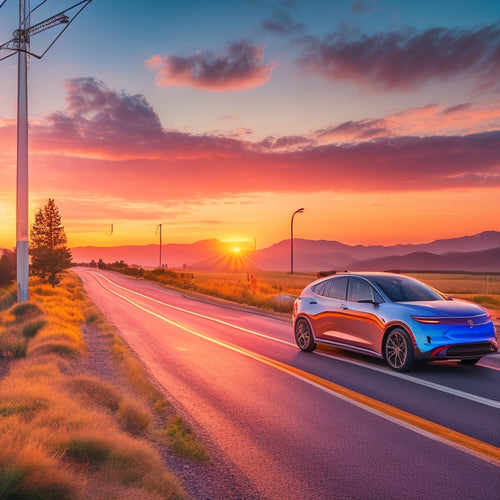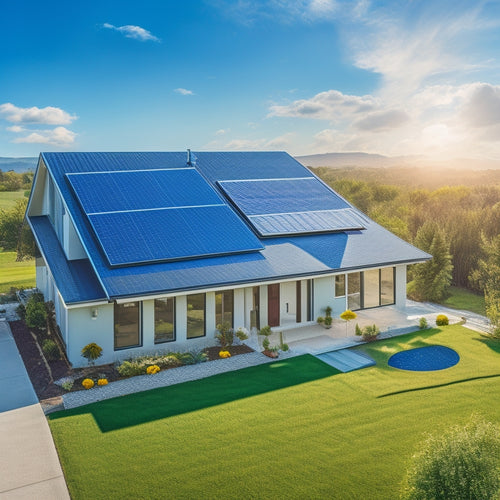
Powering Your Ride: Grid to Vehicle Electric Solutions
Share
You're on the cusp of a transportation revolution, where electric vehicles, energy storage, and the electrical grid converge. Vehicle-to-grid technology transforms your EV into a two-way energy flow system, reducing your carbon footprint and supporting grid resilience. With electric car charging systems offering varying power outputs and charging times, you can choose the best fit for your needs. As you explore grid connection and safety protocols, you'll discover the importance of cybersecurity and advanced security features. Now, as you're poised to harness the power of electric roads and smart charging infrastructure, you're about to uncover the future of sustainable, efficient travel.
Key Takeaways
• Vehicle-to-Grid technology enables electric vehicles to act as energy storage devices, reducing carbon footprint and contributing to grid resiliency.
• Electric car charging systems come in three levels, varying in power output and charging time, with public charging stations available for convenience.
• Grid connection and safety protocols ensure a secure and efficient connection between electric vehicles and the grid, preventing disruptions and cyber threats.
• Smart charging infrastructure optimizes charging schedules, promotes sustainable energy distribution, and alleviates congestion with strategically placed charging stations.
• The future of electric roads promises uninterrupted travel with built-in charging infrastructure, eliminating range anxiety and enabling cleaner, more efficient travel.
Vehicle to Grid Technology
As you explore the world of electric vehicle (EV) technology, you'll discover that Vehicle to Grid (V2G) technology enables your EV to act as an energy storage device, feeding electricity back into the grid when not in use. This innovative solution turns your EV into a two-way energy flow system, allowing you to store and supply energy as needed.
By harnessing the potential of V2G, you're not only reducing your carbon footprint but also contributing to grid resiliency.
In essence, V2G technology converts your EV into a mobile energy storage unit, capable of stabilizing the grid during peak hours or when there's a sudden surge in demand. This synergy between your EV and the grid optimizes energy distribution, ensuring a more efficient and reliable supply.
With V2G, you're an active participant in maintaining grid resiliency, providing a buffer against power outages and supporting the integration of intermittent renewable energy sources.
Electric Car Charging Systems
Now that you've harnessed the potential of Vehicle to Grid technology, you're likely wondering how to replenish your electric vehicle's battery, which brings us to the topic of electric car charging systems. There are several types of charging systems, each with its own benefits and limitations.
| Charging Type | Power Output | Charging Time |
|---|---|---|
| Level 1 (120V) | 1.4 kW | 24 hours |
| Level 2 (240V) | 7.2 kW | 4-8 hours |
| DC Fast Charging | 50-100 kW | 30-60 minutes |
When it comes to public accessibility, you'll find charging stations at shopping centers, parking garages, and along highways. Fast Charging, in particular, has become a game-changer, allowing you to recharge your battery to 80% in under an hour. Many public charging stations now offer Fast Charging capabilities, making long road trips a breeze. As you explore the world of electric car charging systems, you'll discover a multitude of options tailored to your needs, from convenience to speed.
Grid Connection and Safety
You need to guarantee a safe and efficient connection between your electric vehicle and the grid, which demands a thorough understanding of the electrical infrastructure and safety protocols involved.
A seamless connection relies on a resilient grid that can handle the increased demand from EV charging. Grid resilience is essential to prevent brownouts, blackouts, and other disruptions that can impact your daily commute.
Additionally, cybersecurity measures must be in place to protect your vehicle and the grid from potential cyber threats. A compromised connection can compromise not only your vehicle's performance but also the entire grid.
You must make sure that your charging system is equipped with advanced security features that can detect and respond to potential threats in real-time.
Smart Charging Infrastructure
Integrating advanced technologies into charging stations, your vehicle can optimize its charging schedule based on factors like time of day, energy demand, and renewable energy availability, enabling a more efficient and sustainable charging experience.
This smart charging infrastructure allows you to charge your vehicle when energy demand is low, reducing strain on the grid and promoting a more balanced energy distribution.
Urban planning plays an essential role in the development of smart charging infrastructure, as strategically placed charging stations can alleviate congestion and optimize energy distribution.
Additionally, energy storage systems can be integrated into charging stations to store excess energy generated from renewable sources, providing a backup power source during peak demand periods.
By leveraging these technologies, you can enjoy a seamless and sustainable charging experience that not only benefits you but also the environment.
With smart charging infrastructure, you're not just fueling your ride, you're fueling a cleaner, more efficient future.
The Future of Electric Roads
Electric roads, where the highway itself supplies the electricity, are poised to revolutionize the way you recharge your vehicle, making long-distance travel a seamless and sustainable experience. Imagine cruising down the highway, your electric vehicle (EV) effortlessly gliding along, while the road itself provides the power. This futuristic scenario is fast becoming a reality, thanks to the development of Electric Highways.
These innovative roads are equipped with built-in charging infrastructure, allowing your EV to recharge on the go. Autonomous Charging technology enables your vehicle to seamlessly connect and disconnect from the power source, ensuring uninterrupted travel. This game-changing technology is set to transform the way you travel, making long road trips a breeze. No more worrying about running out of juice or searching for charging stations.
With Electric Highways, you'll be free to focus on the journey, not the range anxiety. As the infrastructure continues to expand, you'll be able to travel farther, cleaner, and more efficiently than ever before. The future of electric roads is here, and it's electrifying.
Frequently Asked Questions
Can Electric Vehicles Be Charged Using Alternative Energy Sources?
"Like Achilles' heel, your reliance on fossil fuels can be your weakness, but you can harness the power of the gods with solar farms and wind turbines, charging your electric vehicle with clean, renewable energy."
Are Electric Vehicles More Expensive to Maintain Than Gas-Powered Cars?
You'll be relieved to know that electric vehicles typically require less maintenance than gas-powered cars, but battery replacement costs can add up; a thorough cost analysis reveals that EVs can still be a cost-effective option for you.
Can I Charge My Electric Vehicle at Home Without a Garage?
You can charge your electric vehicle at home without a garage by installing outdoor stations or using a driveway install, allowing convenient and safe charging in your outdoor space.
How Long Does It Take to Fully Charge an Electric Vehicle?
Imagine sipping a cup of coffee while your EV guzzles electrons - it's a similar wait! Depending on your battery capacity, charging timeframes vary: 30 minutes for 80% with a 100kW charger or 8 hours with a 7.2kW Level 2 charger.
Are Electric Vehicles as Environmentally Friendly as They Claim?
You wonder if electric vehicles live up to their eco-friendly reputation. While they produce zero tailpipe emissions, you should consider their carbon footprint, including Production emissions from manufacturing and charging, which can offset some environmental benefits.
Related Posts
-

Best Vehicle Chargers to Keep You Moving
You're looking for a reliable vehicle charger to keep your devices powered up and stay connected on the go. Solar cha...
-

5 Best Steps to Installing Solar Panels at Home
You're about to start on a journey to harness the power of solar energy at home. First, assess your home's solar pote...
-

Selecting Solar Panel Kits for Boat and RV Owners
When selecting a solar panel kit for your boat or RV, you'll want to calculate your daily energy consumption in watt-...


